Photochemistry in liquid crystals
The most important results
-
Contrary to isotropic solvents, unusual concentrational dependence of previtamin D cis-trans isomerization was observed in LCs at the room temperature: both in nematic and cholesteric LCs, the efficiency of cis-trans isomerization increases significantly with rising of 7-DHC concentration.
-
For both nematic and cholesteric LCs, the efficiency of cis-trans isomerization decreased with the temperature rising up to the LC’s clear point, and in isotropic phase no dependence on the 7-DHC concentration was noticed.
-
We have studied the LCs structure and optical properties changes as a result of UV-induced 7-DHC transformations because such investigations are one of the "hottest" areas in the liquid crystal physics today.
-
We established significant differences in the dynamics of cholesteric phase formation depending on the ratio of initial cholesteric pitch value (or the 7-DHC concentration) to the LC cell thickness.
In the case of initial quasy-nematic phase (low 7-DHC concentration) small "islands" of planar-oriented left-handed cholesteric phase appeared at the beginning of UV irradiation and further these regions enlarged and merge with each other. Finally, left-handed cholesteric phase filled the whole LC cell volume. This process was identical in both "thin" (d~20mkm) and "thick" (d~60mkm) LC cells. -
In the case of initial right-handed cholesteric in "thick" LC cell (d~60mkm), under UV irradiation the LC first re-oriented into homeotropic state (fingerprint texture was observed). Further planar-oriented left-handed cholesteric was formed. However, in case of "thin" LC cells (d~20mkm) the fingerprint texture was not stable and arose simultaneously with planar-oriented regions.
-
"Birth" and "Life" of homeotropic cholesteric LC phase.
-
The dynamics of the cholesteric phase induction was studied following the dissolution process of a rod-like steroid crystal (0.1–1mm length) placed at the surface of a nematic drop. Using a polarizing microscope, the rod-like crystal rotation was observed demonstrating the real-time transfer of chiral information. No rotation was observed in the isotropic phase.To the best of our knowledge, this was the first observation of a monodirectional rotation driven by direct transformation of chemical dissolution energy into mechanical rotational energy.
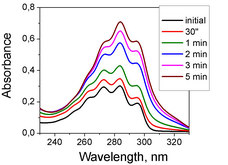 |
||
| From left to right: provitamin D concentration 0.07 wt.%, 0.1 wt.% and 0.8 wt.%. | ||
Gvozdovsky I.A., Terenetskaya I.P. "Comparative study of the provitamin D photoisomerization kinetics in ethanol and liquid crystal", J. Functional materials, 2000, Vol. 7, №3, pp.508-512.
Gvozdovskyy I., Orlova T., Terenetskaya I. "Features of previtamin D cis-trans isomerization in the nematic LC matrices: orientation and cholesteric order effects", Mol.Cryst.Liq.Cryst., 2005, Vol. 434, pp.325(653)-332(660).
Orlova T., Terenetskaya I. "Dual medium effect on previtamin D cis-trans isomerization: the Hula-Twist mechanism in nematic LC matrix at room temperature", Book of Abstracts XX Symposium on Photochemistry, Granada, Spain, 2004, p.461.
Terenetskaya I., Orlova T. "Hula-twist cis-trans isomerization of previtamin D in liquid-crystalline matrix", Book of Abstracts International Symposium of molecular photonics, St. Petersburg, Russia, 2006, pp.144 -145.
Orlova T.N., Terenetskaya I.P. "Specific features of photoisomerization of provitamin D3 in a nematic liquid crystal", Opt.Spectr., 2006, Vol.100, pp.584-589.
Calculated ellipticity of light passed through planar cholesteric structure. |
Orlova T., Terenetskaya I. "UV effects on the spectral and polarization properties of nematic LC with photosensitive chiral dopant", Book of Abstracts International conference "Modern Problems of Condensed Matter Optics", Kiev, Ukraine, 2006, pp.64-65.
Egorov R.I., Orlova T.N., Terenetskaya I.P. "Stokes-polarimetry of UV-induced cholesteric pitch changes", NASU Reports, 2006, Vol.11, pp.73-78 [in Russian].
 |
 |
 |
| You can download full movie by click on preview picture. | ||
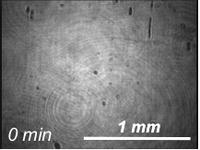 |
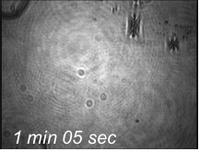 |
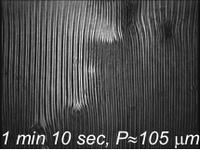 |
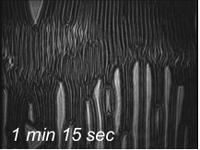 |
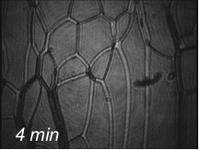 |
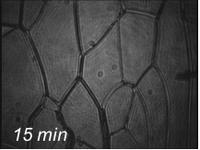 |
| Dynamics of the cholesteric phase re-orientation (photos in the crossed polarizers). | ||
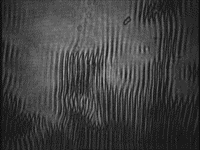
| 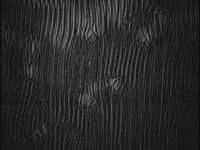 |
| "Birth" and "Life" of homeotropic cholesteric LC phase. You can download full movie by click on preview picture. | |
I. Gvozdovskyy, I. Terenetskaya "Steroid motor: dynamics of cholesteric helix induction in the nematic droplet", Liquid Crystals Today, 2002, Vol.11, №4, pp.8–12.
More information at http://www.iop.kiev.ua/~gvozdovskyy/